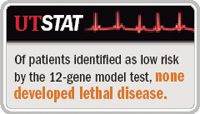Article
Molecular signatures may predict lethal prostate cancer
Author(s):
Chicago-One of the most difficult issues in the management of prostate cancer is identifying which men with indolent disease are at increased risk of progressing to more advanced disease. Reliance on traditional clinical prognostic factors, including PSA, has provided some guidance on treatment, but all too often, men with indolent disease are over-treated based on an incomplete knowledge of disease risk.
Chicago-One of the most difficult issues in the management of prostate cancer is identifying which men with indolent disease are at increased risk of progressing to more advanced disease. Reliance on traditional clinical prognostic factors, including PSA, has provided some guidance on treatment, but all too often, men with indolent disease are over-treated based on an incomplete knowledge of disease risk.
New prognostic indicators currently under investigation may one day solve this dilemma and give physicians and patients alike more assurance that the treatment prescribed is the treatment needed.


Difficult to ID intermediate risk
The main problem with the predictive value of these molecular signatures is that they are good at identifying high- and low-risk disease, but not so good at identifying intermediate-risk disease, Dr. Rubin said.
Future directions in such areas as gene fusion may provide even better ways to identify patients at high risk of lethal disease. According to Dr. Rubin, the most common gene fusion in prostate cancer is that of TMPRSS2 and ETS, which occurs early in the development of prostate cancer and is seen only in a subset of men with high-grade prostate intraepithelial neoplasia.
"This new gene fusion is being examined to be detected by a urine test because if it is positive, it is going to be a good supplement to PSA," he said. "If it is positive, you have cancer."
Dr. Rubin emphasized that these new prognostic factors will be used to augment the currently used clinical markers.
"The gene fusion test or any molecular test we would have would first be evaluated in the context of all the other information," he said. "There might be a time where it provides more information than the other clinical parameter, but currently, the approach is that you take all the information together and understand it in context."
Ian M. Thompson, MD, chairman of the department of urology at the University of Texas Health Science Center at San Antonio, agreed.
"We have very good evidence that Gleason, PSA, and stage all participate in risk. I doubt very much that markers will replace these, but will augment them," Dr. Thompson said. "If you ask me to predict how new markers will participate in this process, I suspect that we'll have risk calculators for prostate cancer prognosis, as well. Dr. Rubin's research is extremely important to move this process forward."
















